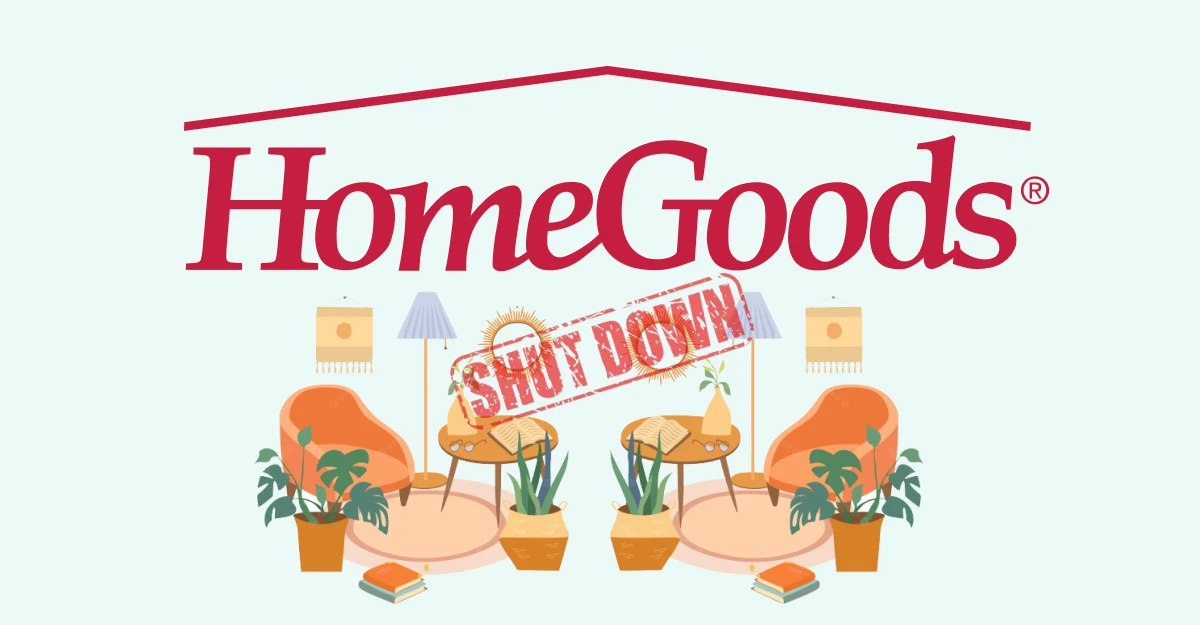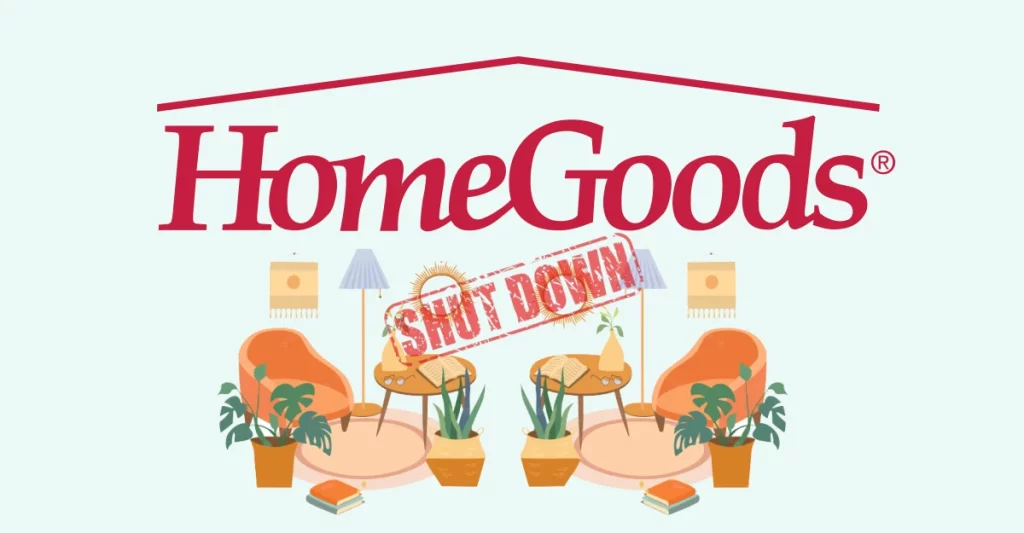In the bustling world of retail, even well-established stores like HomeGoods have faced challenges that led to their unfortunate closures. Current retail news is filled with headlines related to the closing of Home Goods Stores in major US regions including Texas and California. Home Goods closing has created a storm of disappointments and worries among retailers.

What could be the reason behind it?
Let’s uncover the whole story in this write-up.
Stay tuned!
HomeGoods: A Famous Retail Store
HomeGoods is a popular chain of off-price home furnishing stores in the United States. It is owned by TJX Companies, the same parent company that operates T.J. Maxx and Marshalls. HomeGoods specializes in offering a wide variety of home goods and décor items at discounted prices.
The store’s inventory includes furniture, rugs, lighting, kitchenware, bedding, bath accessories, decorative items, and more. The appeal of HomeGoods lies in its constantly changing inventory, as the store receives new shipments of merchandise on a regular basis. This “treasure hunt” shopping experience makes it enticing for customers to visit frequently in search of unique and stylish finds for their homes.
A Brief Overview of the Company
Home Goods is known for carrying brand-name and designer items at significantly lower prices compared to traditional retail stores. The merchandise is often sourced from closeouts, overstock, and discontinued lines, which allows the store to offer substantial savings to its customers. This model has contributed to HomeGoods’ popularity among budget-conscious shoppers and those seeking to refresh their living spaces affordably.
| Name of the Company | HomeGoods |
| Type of Company | Subsidiary Company |
| Industry (Operating Segment) | Retail Segment |
| Parent Company | TJX Companies |
| Founded | 1992 |
| Headquarters | Framingham, Massachusetts, USA |
| Number of Store Locations (as of 2020) | 814 |
| Products | Bedding, Furniture, Housewares, Lighting |
| Annual Revenue (2022) | $22 million |
Some of the common queries of folks are-
Who owns Home Goods?
TJX Companies owns Home Goods. It is a sister company to T.J. Maxx, Sierra Trading Post, and Marshalls. As of 2020, there were 814 Home Goods store locations. But now the numbers are declining drastically due to Home Goods closing.
What was the revenue of Home Goods?
It earned a revenue of $22 million in the year 2022.
In other regions like Canada and Europe, TJX Companies operates as a similar home furnishing chain. But it is called “HomeSense.” Soon, they will open 400 HomeSense stores in the US.
Reasons for Home Goods Closing
This is the most anticipated part of the topic. One of the main reasons behind this phenomenon is the fading foot traffic. It refers to the diminishing number of customers walking through the store’s doors.
This decline in physical visitors can be attributed to several factors, each playing a role in the gradual closure of Home Goods retail stores.
Let’s look at some of the major factors that led to Home Goods closing-
1. The Rise of E-Commerce Titans: Digital Dominance
The digital revolution has transformed the way people shop, making online purchases as easy as a few clicks. E-commerce giants like Amazon offer convenience, competitive prices, and a vast array of options. Many consumers are opting to fill their virtual shopping carts rather than perusing physical store aisles.
The allure of doorstep delivery and the ability to comparison shop online have pulled customers away from brick-and-mortar stores, including Home Goods.
2. Changing Consumer Preferences: Shift towards Experience
Modern consumers are seeking more than just products; they’re seeking experiences. This shift in preferences has led to the popularity of stores that offer not just items but an immersive shopping experience.
Home Goods, despite its array of home decor treasures, have struggled a lot. It went through a rough patch to keep up with the demand for experiential retail environments. Thus, they couldn’t engage shoppers and keep them coming back for more.
3. Online Discounts and Deals: Digital Bargain Hunting
Who doesn’t love a good deal? Online retailers often provide attractive discounts, promotions, and exclusive offers that can be difficult for physical stores to match. Home Goods faced challenges in maintaining their price competitiveness compared to enticing online bargains. Thereby, it led some customers to opt for the cost-effective convenience of virtual shopping.
4. Convenience and Time Crunch: Fast-Paced Lifestyles
In today’s fast-paced world, time is a precious commodity. Consumers are juggling multiple responsibilities, leaving them with limited time for leisurely in-store shopping. Online shopping offers the convenience of browsing and buying at any time, without the need to physically visit a store.
This newfound flexibility has played a significant role in the declining foot traffic at Home Goods and other traditional retail outlets.
5. Pandemic Pressures: A Digital Surge
The COVID-19 pandemic amplified the challenges faced by brick-and-mortar retailers, including Home Goods. Lockdowns and health concerns prompted a surge in online shopping. This accelerated the shift towards e-commerce and created an environment that favored digital transactions over in-person visits.
This unprecedented crisis further expedited the store’s closure, as the demand for online shopping continued to rise.
6. Some Other Reasons for Home Goods shut down
| Reasons | Description |
| Rising Operational Costs | Increasing rent and overhead expenses for physical store locations. High labor costs and employee wages. |
| Supply Chain Disruptions | Challenges in sourcing products due to global supply chain disruptions. Delays in product availability affect customer satisfaction. |
| Economic Factors | Economic downturns lead to reduced consumer spending. Uncertainty impacting discretionary purchases. |
| Reallocation & Resources | Company’s strategic decision to focus on other business segments. Investment in more profitable ventures within the same company. |
| Lack of Innovation & Adaptation | Failure to adapt to changing retail technologies and customer engagement strategies. Stagnation of in-store layout, design, and overall shopping experience. |
| Local Market Dynamics | Store locations in areas with declining populations or changing demographics. Failure to resonate with the local consumer base. |
Final Words
In the ever-evolving landscape of retail, the closure of Home Goods retail stores can be attributed to a complex interplay of factors. From the convenience of e-commerce to changing consumer preferences and external crises. The lesson here is clear. Adaptability and innovation are crucial for retailers to stay afloat and thrive in the face of these challenges.

